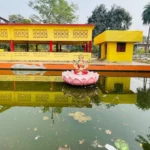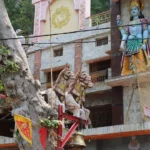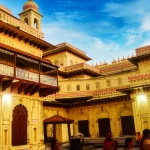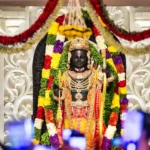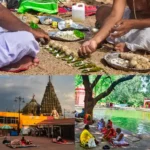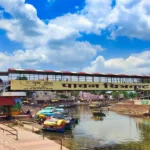Cultural Significance
Preservation of Mythological Tales: The temple is steeped in mythological tales that resonate with the epic Ramayana. It serves as a cultural treasure, preserving these timeless tales for future generations. The depictions of scenes from the Ramayana on the temple walls serve as a visual narrative, enriching the cultural heritage of Ayodhya.
Architectural and Artistic Showcase: Beyond its religious importance, Kanak Bhawan is a testament to the cultural synthesis and artistic prowess of the craftsmen of yore. The temple’s architecture and artistic elements, such as its intricate carvings and vibrant paintings, reflect the rich cultural heritage of the region.
Cultural Hub in Ayodhya: As a prominent landmark in Ayodhya, Kanak Bhawan contributes significantly to the cultural milieu of the city. It attracts not only pilgrims but also tourists and scholars, making it an integral part of Ayodhya’s cultural and historical narrative. The temple’s role in various cultural events and its impact on the local community highlights its importance as a cultural hub.
Tales Entwined with the Ramayana
Gift from Queen Kaikei to Goddess Sita: One of the most prominent legends associated with Kanak Bhawan is that it was a gift from Queen Kaikei to Goddess Sita immediately after her marriage to Lord Rama.

This act is symbolic of the deep respect and affection Kaikei had for Sita, despite the later events in the Ramayana. This story not only adds a layer of mythological significance to Kanak Bhawan but also reflects the intricate familial relationships depicted in the epic.
The Miraculous Appearance of the Golden Palace: According to another legend, when Sita entered the palace gifted by Queen Kaikei, she found an exquisite golden abode, believed to be Kanak Bhawan. The legend suggests that the palace miraculously appeared when Sita entered her chambers, emphasizing the divine intervention and the special status accorded to Sita in Hindu mythology.
Manifestation of the Idols: There’s a fascinating legend about the idols of Lord Rama and Sita in Kanak Bhawan. It is said that these idols miraculously manifested in the temple and would change their appearance and attire daily, captivating the priests and devotees. This legend underscores the divine power of the deities and the temple’s role as a living embodiment of their presence.
Connection to Lord Krishna: Another intriguing aspect of the temple’s mythology is the belief that one of the pairs of idols in the temple was given by Lord Krishna to a woman hermit meditating on Lord Ram at this site. This connection to another major deity in Hinduism, Lord Krishna, adds another layer of religious significance to Kanak Bhawan and reflects the interconnectedness of Hindu myths and deities.
Pilgrim Experience
Spiritual Atmosphere: The atmosphere at Kanak Bhawan is imbued with spirituality and tranquillity, offering pilgrims a serene environment for worship and contemplation. The temple’s association with Lord Rama and Goddess Sita elevates its sanctity, making it a revered site for Hindu devotees. The air often resonates with the sounds of bhajans and prayers, adding to the spiritual ambience.
The Divine Idols and Darshan: Central to the pilgrim experience at Kanak Bhawan are the darshan (sighting) of the deities. The temple houses unique idols of Lord Rama and Sita, adorned with gold crowns and heavy ornaments. Pilgrims often report a sense of divine connection and inner peace upon viewing these sacred idols, which are believed to embody the presence of the deities.
Cultural and Historical Insights: For those interested in the cultural and historical aspects, Kanak Bhawan offers a rich tapestry of mythological stories and architectural brilliance. The temple’s walls and structures narrate tales from the Ramayana and the intricate carvings and paintings provide a glimpse into the artistic heritage of the region.

Festivals and Celebrations: The experience of visiting Kanak Bhawan during major Hindu festivals like Ram Navami is particularly vibrant. The temple becomes a hub of festive activities with special rituals, offerings, and cultural programs. These celebrations provide pilgrims and visitors with an opportunity to partake in traditional practices and observe religious ceremonies up close.
Introspection and Prayer: Many pilgrims visit Kanak Bhawan for introspection and prayer. The temple’s peaceful environment allows for moments of reflection and a deeper connection with the divine. The rhythmic chants, the ringing of temple bells, and the fragrance of incense create an immersive experience that transcends the mundane world.
Community and Sharing: The temple also serves as a place for community gathering and sharing of beliefs. Pilgrims from diverse backgrounds come together, sharing their experiences and stories, thus fostering a sense of unity and communal harmony.
Tourism Aspect
Major Tourist Attraction in Ayodhya: Kanak Bhawan is not only a significant religious site but also a major tourist attraction in Ayodhya. Its rich history, architectural beauty, and religious importance draw not just pilgrims but also history buffs, architecture enthusiasts, and cultural tourists. The temple’s connection to the epic Ramayana adds to its allure as a destination for those interested in exploring India’s mythological and cultural heritage.
Guided Tours and Cultural Insights: Many tourists visit Kanak Bhawan to gain insights into its architectural grandeur and mythological significance. Guided tours are available, providing detailed information about the temple’s history, architecture, and the legends associated with it. These tours offer an educational and enlightening experience for visitors, enhancing their understanding of Indian culture and history.
Photography and Artistic Inspiration: The temple, with its intricate carvings and vibrant paintings, serves as a splendid subject for photography and artistic inspiration. Tourists and artists alike are drawn to its aesthetic appeal, capturing its beauty through various forms of art and photography.

Integration in Local Tourism Circuits: Kanak Bhawan is often included in local tourism circuits, which cover other important sites in Ayodhya like Ram Janmabhoomi, Hanuman Garhi, and Nageshwarnath Temple. This integration allows tourists to experience the diverse aspects of Ayodhya’s religious and cultural landscape.
Impact on Local Economy and Community: The influx of tourists to Kanak Bhawan contributes significantly to the local economy. Local businesses like hotels, restaurants, and souvenir shops benefit from the increased footfall, thus supporting the livelihood of the local community. This economic impact underscores the temple’s role in boosting Ayodhya’s tourism sector.
Accessibility and Facilities: Kanak Bhawan is well-accessible to tourists, with various transportation options available to reach Ayodhya. The temple and the surrounding areas are equipped with facilities like accommodation, eateries, and information centres, making it convenient for tourists to plan their visit.











